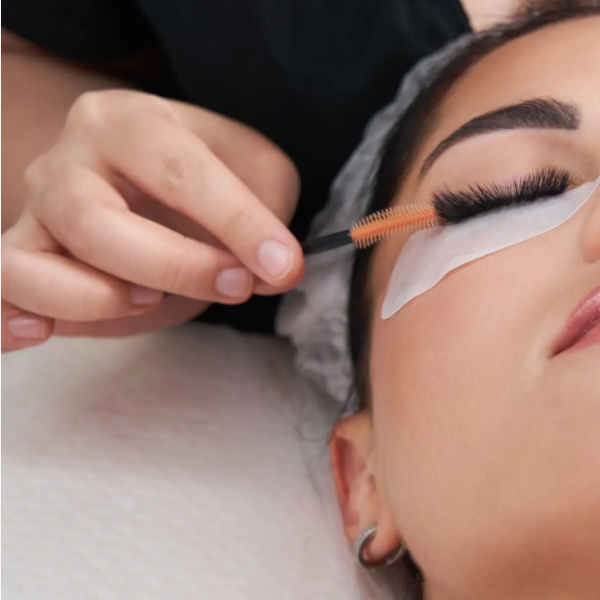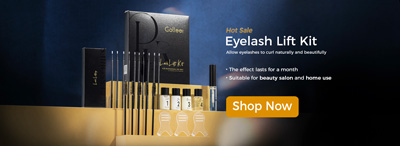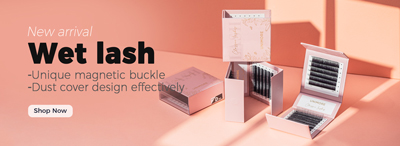Eyelash extensions have skyrocketed in popularity over the past few years, with countless individuals seeking longer, fuller lashes. According to a 2022 survey, the global eyelash extension market is expected to grow significantly, reaching $1.6 billion by 2027. This surge highlights the importance of understanding the products we apply so close to our eyes.
While eyelash extensions can enhance your beauty routine, it's vital to know what ingredients are in the glue used to apply them. The components of lash glue play a significant role in the safety and health of your eyes and skin. Uninformed use could lead to allergic reactions, irritation, and other health concerns. In this article, we will share the valuable inside knowledge we have gathered over seven years as a salon pro eyelash glue supplier. You can make safer choices for your beauty regimen by understanding the common ingredients found in eyelash extension glue.
Common Ingredients in Eyelash Extension Glue
1. Cyanoacrylate
Cyanoacrylate is a fast-acting adhesive used in medical, industrial, and cosmetic applications. In eyelash extension glue, cyanoacrylate serves as the main adhesive component, ensuring a strong bond between the natural lash and the extension. Different types of cyanoacrylate include ethyl, methyl, and butyl, each offering varying levels of strength and drying times, catering to different application needs.
Cyanoacrylate is the key ingredient in professional eyelash extension glues. It ensures the adhesive dries quickly and holds lashes securely in place for weeks. This compound gives the glue its unique curing property, allowing it to dry in seconds and providing a strong bond essential for long-lasting eyelash extensions. Cyanoacrylate is present in all eyelash adhesives, including those formulated for sensitive or allergic eyes. What many people are unaware of is that there are five different types of cyanoacrylate, each with distinct characteristics.
Among these, ethyl cyanoacrylate is the most widely used. It offers a fast drying time and strong adhesion, making it ideal for quick applications and providing a durable hold. On the other hand, it is known for its gentle, making it a preferred choice for individuals with sensitive eyes. What's more, it is favored for its flexibility, ensuring that the bond between the natural lash and the extension remains intact despite movements.
2. Hydroquinone
Hydroquinone is a chemical compound often used in cosmetics and adhesives. In lash glue, hydroquinone acts as a stabilizer, helping to extend the shelf life of the product and maintain its adhesive properties over time.
Hydroquinone works by preventing the polymerization of the adhesive, thus ensuring that the glue remains effective over a longer period. This is particularly important for professional lash artists who need to ensure that their products do not degrade prematurely.
3. Carbon Black

Carbon black is an ingredient in eyelash extension glue that gives the adhesive its deep black color. It provides the glue with a deep black color, enhancing the aesthetic appeal by blending seamlessly with natural lashes. While generally safe, carbon black can cause allergic reactions in some individuals. It's essential to monitor for any signs of sensitivity. This is only found in black adhesives and is not used in clear adhesives, making transparent glue a suitable option for those with allergies to carbon black.
Carbon black is derived from the incomplete combustion of heavy petroleum products and is used in various cosmetic products for its pigmentation properties. In eyelash extension glue, carbon black enhances the visual appeal by creating a seamless look that matches natural lashes. However, for those with sensitive skin or allergies, clear adhesives, which do not contain carbon black, can be a safer alternative.
4. Latex
Latex is a natural rubber material used in various products. In eyelash extension glue, latex adds flexibility, ensuring the glue moves with the natural lash and reducing the risk of breakage. Latex allergies are relatively common. If you have a known latex allergy, seek latex-free alternatives to avoid adverse reactions. Gollee Salon Pro eyelash glue suppliers now opt for latex-free eyelash glue formulas to prioritize client safety.
Latex's flexibility helps maintain the integrity of the lash extensions, allowing them to endure the natural movements of the eyes and face without breaking or causing discomfort. However, due to the prevalence of latex allergies, Gollee professional-grade eyelash glues are formulated without latex, ensuring that they are safe for use by a wider range of clients.
5. Other Ingredients
Some eyelash glues may contain other chemicals, such as formaldehyde, which is known for its preservative and adhesive properties. However, formaldehyde is a known irritant, making it a controversial ingredient. Technically speaking, all eyelash extension glue contains formaldehyde.
Formaldehyde is not an added ingredient but is formed as a by-product during the production process by the decomposition of other components in the eyelash extension glue. A completely “formaldehyde-free” lash extension adhesive does not exist. Also, ultra-low amounts of formaldehyde naturally occur as the adhesive degrades over time. The formaldehyde level in Gollee professional adhesives is often below the lowest detectable level of lab tests that measure formaldehyde.
Understanding the presence of formaldehyde in eyelash adhesives is crucial for making informed decisions. While the levels present in high-quality glues are minimal and generally considered safe, individuals with known sensitivities should be cautious and seek products that minimize formaldehyde exposure.
Potential Health Effects of Eyelash Extension Glue Ingredients
1. Allergic Reactions
Common signs of allergic reactions to lash glue include redness, itching, swelling, and burning sensations around the eyes. To prevent allergic reactions, always perform a patch test before full application. This involves applying a small amount of glue to your skin and monitoring for any adverse reactions over 24-48 hours.
Allergic reactions are often caused by ingredients such as cyanoacrylate, carbon black, and latex. Performing a patch test can help identify sensitivities before the glue is applied near the eyes, where reactions can be more severe. If you experience any signs of an allergic reaction, it is crucial to discontinue use immediately and consult a healthcare professional.
2. Eye Irritation and Infections
Certain ingredients, particularly harsh chemicals, can cause eye irritation or infections if they come into contact with the eyes or surrounding skin. Irritation may manifest as redness, itchiness, and watering eyes. If you experience these symptoms, remove the extensions and glue immediately and consult a healthcare professional for treatment.
Eye irritation can result from improper application techniques, using low-quality products, or individual sensitivities to certain chemicals. Maintaining proper hygiene and following professional guidelines for application can help minimize the risk of irritation and infections. It's also important to choose high-quality, professional-grade products that adhere to safety standards.
3. Patch Tests
To perform a patch test, apply a small amount of glue to an inconspicuous area of skin, such as behind the ear or on the inner forearm. Wait 24-48 hours to check for any reactions. Patch testing is crucial for identifying potential allergic reactions before applying the glue to your eyes.
Patch tests are a simple yet effective way to ensure that you do not have an adverse reaction to a new product. This step can prevent serious discomfort and health issues, making it a vital part of your beauty routine. Always perform a patch test with any new product, even if you have used similar products in the past, as formulations can change.
Experience the Best with Gollee's Professional Eyelash Extension Glue
At Gollee, we understand the importance of using high-quality products to ensure a successful and safe eyelash extension application. That's why we're proud to offer our professional-grade eyelash extension glue, designed specifically for use by professional eyelash artists.
1. Safe and Reliable Ingredients
Our glue is made with safe ingredients such as ethyl cyanoacrylate and acrylic polymer, which provide a strong and long-lasting bond. We've also passed the strict safety standards of MSDS and FDA, giving you peace of mind when using our product.
2. No Latex, No Risk
Unlike other glues on the market, our adhesive does not contain latex ingredients, minimizing the risk of adverse reactions. This makes our glue a trustworthy choice for eyelash artists who prioritize their clients' safety and comfort.
3. Improved Formula for Enhanced Durability and Comfort
Our special improved formula not only enhances the durability of your eyelash extensions but also ensures they stay safe and comfortable. Whether you're looking for a reliable and high-performance adhesive for everyday use or a special occasion, Gollee's glue is the perfect solution.
4. Experience the Excellence of Gollee

At Gollee, we're committed to providing products that combine quality, safety, and excellence. Our professional-grade eyelash extension glue is no exception. With its fast-setting formula, strong bond, and focus on safety, it's the perfect choice for any professional eyelash artist.
5. Join the Gollee Family
By choosing Gollee's professional eyelash extension glue, you're not just getting a high-quality product – you're joining a community of professionals who share our commitment to excellence and customer satisfaction. Experience the best with Gollee today.
Conclusion
When choosing the right eyelash glue, several factors should be considered to ensure both the quality and safety of the extensions. First, it is essential to select a waterproof glue that suits the specific conditions of your working environment. This will ensure the extensions remain secure even in humid or wet conditions.
Proper storage techniques are also critical. Eyelash glue should be stored in a cool, dry place, away from direct sunlight and extreme temperatures. This helps maintain the adhesive's effectiveness and extends its shelf life.
For clients with sensitive skin, choosing hypoallergenic or latex-free glues is imperative. These options are formulated to minimize the risk of allergic reactions and provide a comfortable experience for clients. Additionally, low-fume adhesives can be beneficial for reducing irritation and ensuring a pleasant application process.
It is also vital to understand that the ingredients in lash extension adhesives can vary widely between different brands. Evaluating and comparing these components can help you find the best products for your needs. Keeping detailed notes on which glues perform best for your specific skill level and cater to the unique needs and sensitivities of your clients will help you deliver consistently excellent results.






